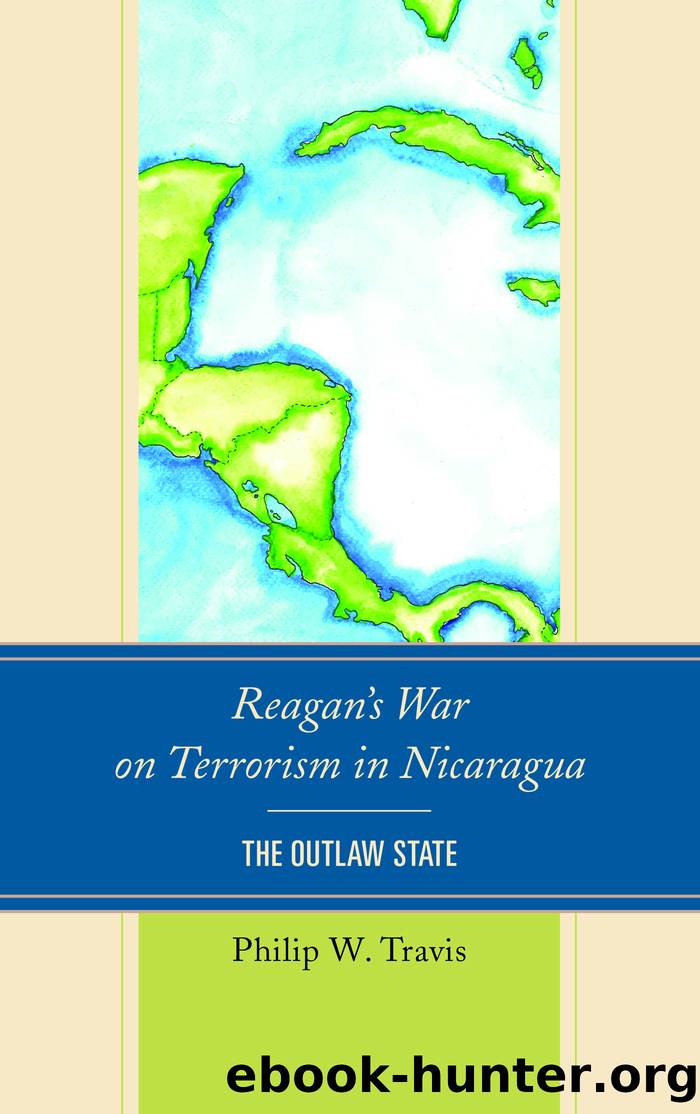Reagan's War on Terrorism in Nicaragua by Travis Philip W.;

Author:Travis, Philip W.;
Language: eng
Format: epub
Tags: undefined
Publisher: Lexington Books/Fortress Academic
Published: 2012-09-15T00:00:00+00:00
George H. W. Bush led the way in advocating an aggressive preemptive counterterrorist campaign against Sandinista-led Nicaragua. In Central America, the United States used the Contras to fight the increased threat from state sponsors of terrorism.[37]
Perhaps, at first glance, it seems strange that George H. W. Bush and George Shultz promoted an aggressive unilateral offensive against state sponsors of terrorism while simultaneously leading the United States toward greater cooperation and coexistence with the Soviet Union and Mikhail Gorbachev. Despite assertions by some of the complicity of the Soviet Union in terrorism, by the second term this perspective on terrorism appeared to change in light of greater cooperation between Gorbachev and the Reagan administration. Bush and Shultz understood the late 1980s as a time of transition. During Reaganâs second term the United States pursued greater cooperation with the Soviet Union, but in doing this it also escalated its offensive counterterrorism war. Bush and Shultz believed that terrorism threatened both the Soviet Union and the United States. In American Legion, the Vice President insisted that increased diplomacy with the Soviet Union âindicates a developing consensus among all nations, including the Soviets, that terrorism is unacceptable international behavior.â Bush and Shultz, the leaders of policy, pursued a greater coexistence with the Soviet Union while simultaneously constructing an aggressive counterterror war against Nicaragua and others alleged of facilitating the new threat of international terrorism.[38]
Several days after the September 18 meeting, Admiral Holloway led an envoy to Great Britain, Ambassador Edward Peck and Robert Earl to Central and South America, Dave Cole to Italy, and Dave McNunn to the Middle East. The purpose was to visit the places most urgently threatened by international terrorism. Ambassador Peckâs group visited the two places considered most at risk by Nicaraguan backed terrorism, El Salvador, and Colombia.[39] On this trip, the task force members met with heads of state, military officials, and businessmen that were involved in projects like the Colombian oil pipeline.[40] NSC members John Poindexter and Charles Allen both adamantly opposed Peckâs visit to San Salvador. The situation in El Salvador remained very dangerous and the two feared that urban terrorists with affiliation to the FMLN and to the Sandinistas might target the envoy as reprisals for the US-backed El Salvador offensive in July. Their concern was not without warrant. Ambassador Thomas Pickering had two attempts on his life thwarted by the United States and the El Salvadoran government a year earlier.[41] Peck, however, insisted, âThe trip [was] necessary to insure that the final report has a proper assessment of the terrorist threat worldwide [and] El Salvador is a particularly important country to visit because of the ongoing terrorist activity.â[42] The administration took the terrorism crisis seriously and intended to create a complete understanding of the situation and a coherent framework of intervention in response.
On October 7, 1985, international events again reminded the world of the danger. The world watched as terrorists with links to the PLO hijacked the cruise ship Achille Lauro in the Mediterranean. In
Download
This site does not store any files on its server. We only index and link to content provided by other sites. Please contact the content providers to delete copyright contents if any and email us, we'll remove relevant links or contents immediately.
| Belize | Costa Rica |
| El Salvador | Guatemala |
| Honduras | Nicaragua |
| Panama |
Cat's cradle by Kurt Vonnegut(13903)
Pimp by Iceberg Slim(12950)
Underground: A Human History of the Worlds Beneath Our Feet by Will Hunt(11274)
4 3 2 1: A Novel by Paul Auster(11078)
The Radium Girls by Kate Moore(10923)
American History Stories, Volume III (Yesterday's Classics) by Pratt Mara L(4829)
Perfect Rhythm by Jae(4630)
Wiseguy by Nicholas Pileggi(4606)
The Fire Next Time by James Baldwin(4354)
Paper Towns by Green John(4179)
A Higher Loyalty: Truth, Lies, and Leadership by James Comey(4044)
Pale Blue Dot by Carl Sagan(4019)
The Mayflower and the Pilgrims' New World by Nathaniel Philbrick(3921)
The Doomsday Machine by Daniel Ellsberg(3742)
Too Much and Not the Mood by Durga Chew-Bose(3702)
Killers of the Flower Moon: The Osage Murders and the Birth of the FBI by David Grann(3629)
The Borden Murders by Sarah Miller(3597)
The Sympathizer by Viet Thanh Nguyen(3528)
Killing England by Bill O'Reilly(3466)
